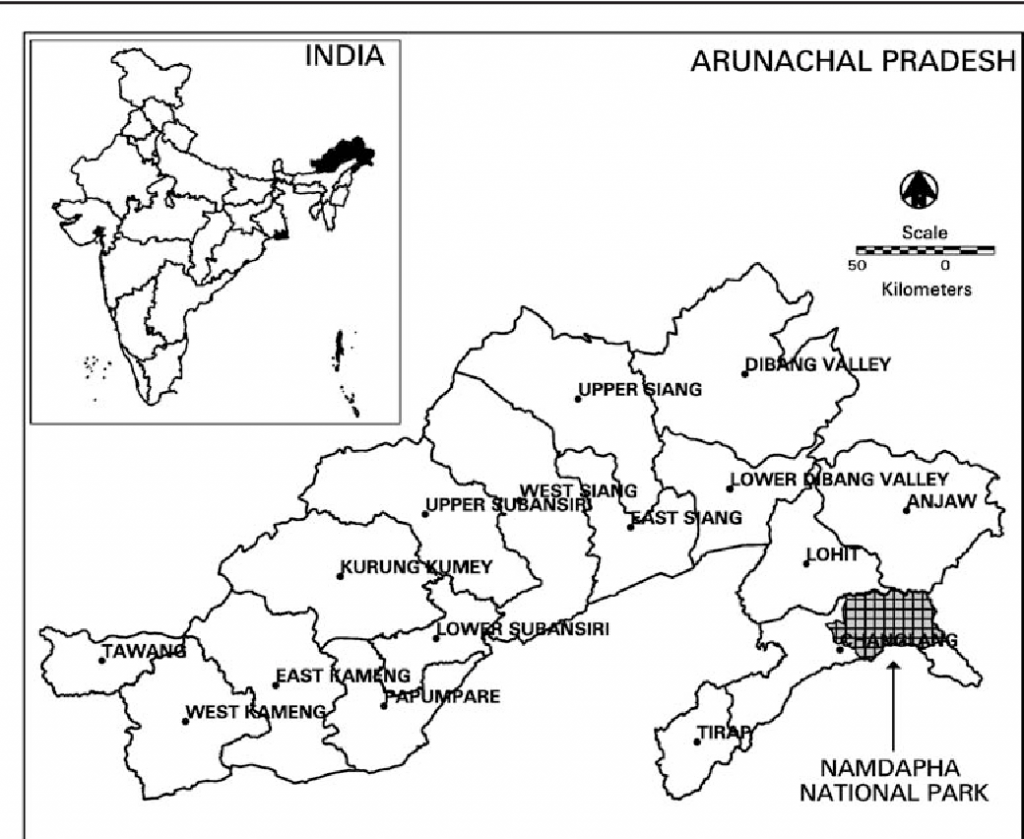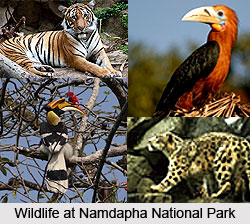Namdhapa National Park: Introduction
Namdhapa National Park in Arunachal Pradesh
Namdapha Tiger Reserve was declared in the year 1983 as the 15th Tiger Project of the country
The park has a core area of 1808 Sq.Km and a buffer area of 177 Sq.Km.
Thus the total area of the Reserve is 1985 Sq.Km.
Namdapha is in fact the name of a river which originates from Daphabum (Dapha is the name of hill, Bum means peak of hill) and meets Noa-Dehing river.
This river flows right across in a North-South direction of the National Park and
Hence the name Namdapha has been given.
In local Singphoo language Nam means water or river and Dapha is the name of a clan of Singphoo tribe.

Location: The area lies between the 27023’N to 27039’N latitude and 96015’E to 96058’E longitude. The Namdapha Protected area is located in the Changlang district of Arunachal Pradesh.
The area covered by the Namdapha Tiger Reserve was originally a reserve forest under the Assam Forest Regulation Act 1891. It was declared a Wildlife Sanctuary under the Assam Forest Regulation Act 1891 on 2nd Oct.’1972.
It was later declared a National Park on 12th May 1983, under Wildlife (Protection) Act 1972.
In the same year, Govt. of India declared park as a tiger reserve under Project Tiger Scheme on 15th March’1983.
In addition, 177.425 Sq. Kms Reserve Forests was added to the Tiger Reserve on 7th Feb.’1986.
Namdhapa National Park in Arunachal Pradesh
The area falls within the Eastern Himalayan biogeographic province of the Himalayas Biogeographic zone which covers the Palaearctic Realm and the Indo-Malayan (Oriental) Realm.
It is located at the junction of the Indian Sub-Continent Biogeograhic region and the Indo-China Biogeographic Region . As a result of this, we observe extensive diversity of flora and fauna in this belt. The Biomes recognised are evergreen Forests, Moist deciduous forests, sub-tropical forests, Temperate Forests and Alpine.
The Namdapha protected area is wedged between Dapha Bum ridge of Mishmi Hills, outspurs of North Eastern Himalayas and Patkai Ranges.
Climate: The Namdapha Protected area being 270N of equator, falls within the geographical sub-tropical zone and enjoys the sub-tropical climate.
However, the climate of the area varies from place to place inside the Protected Area due to variation of altitude from 200 m to 4571m and the area also being the zone of heavy rainfall.
The mountainous part of the area enjoys mountain type of climate while the low lying plains and valleys experience tropical climate. The seasons can be broadly classified into following types:
a. The Cold season from Dec. to Feb.
b. The pre-monsoon season from Mar. to May
c. The south west Monsoon season from June to September
d. The pos Monsoon season from Oct. to Nov.
Vegetation found in Namdhapa National Park
Vegetation: The unique geographical position, varied topography, high annual precipitation spreading throughout the year have made this virgin forest very rich in floral diversity in contrast not a single species can be termed as the dominant species of the area. The climate condition with favorable rainfall coupled with temperature gradients and high humidity makes the vegetation characteristic of tropical evergreen forests (Tropical Rain Forests) although the region is located 270N of geographical equator. The flora of Namdapha protected areas is exceptionally rich, dense and diverse in species composition.
It supports several endemics that have evolved locally or have survived only because of protective natural barriers against the invaders. In the phytogeographical relationship and affinities, the flora of Namdapha Protected Area show greater affinities with Indo-Malayan flora, although it also harbors the plants of other part of India, neighbouring as well as far off countries along with its own flora.
On the basis of survey carried out in parts of this Protected Area it is found that there are 73 species of lichens, 59 species of Bryophytes, 112 species of Heridophytes, 5 species of Gymnosperons and around 801 species of Angiosperms (Sharma et. Al 1990).
These do not include the floral elements of temperate and alpine regions which are unexplored due to inaccessibility and lack of infrastructure.
Tribal People around Namdhapa National Park
Ethnobotany: The tribal population inhabiting the Changlang and Lohit districts which surround this protected area belong to different ethnic background and has very rich cultural traditions.
With their ingenious skill and close association with plants growing over the wide ecological utilization of the plants in their surrounding forests.
They use individual plant parts or combination of several plants or their parts in different proportions in their daily life.
By and large they confine these knowledge to themselves as closed secrets handed over by generations to generations. However, they hesitate to disclose or share this information with others due to superstitious beliefs.
Though Scientists have done no work for detailed ethno botanical studies and follow up pharmacological , Scientific fraternity has established the effective traditional ways and uses of different species in folklore, as supplementary food plants and in curing different ailments
The ethobiology is related to the myths, beliefs, customs, rituals and life style of the tribal people. Annexure – III has listed some of these plants of ethno botanical importance along with their uses.
Namdhapa National Park in Arunachal Pradesh

Fauna: Namdapha PA is located at the junction of the Indian Sub-Continent Biogeography region and the Indo-China Biogeography Region.
Moreover, according to Kurup (1974) this belt is a faunal gateway through which the Indo-Chinese elements of the oriental as well as Palaearctic fauna could spread to India and colonize when the Indian Peninsula and Asiatic mass were linked through land mass.
The most of the faunal dispersal has taken place through this gateway due to the natural barriers of the Thar desert in the West, the great oceans in the South and the high Himalayas in the North.
As a result of this, we observe extensive diversity of fauna due to the fact that in every group along the evolutionary pathway, a large and diverse species complex exist in the area.
The faunal groups inhabiting soil, ground, litter, under stone, decaying woods and grasslands are 1285 species as below. For example

Earthworms- 10 species.
Leeches-5 species.
Insects-430 species.
Butterflies & Moths-140 species.
Fishes- 76 species.
Amphibians-25 species.
Reptiles-50 species.
Birds-453 species.
Mammals-96 species.